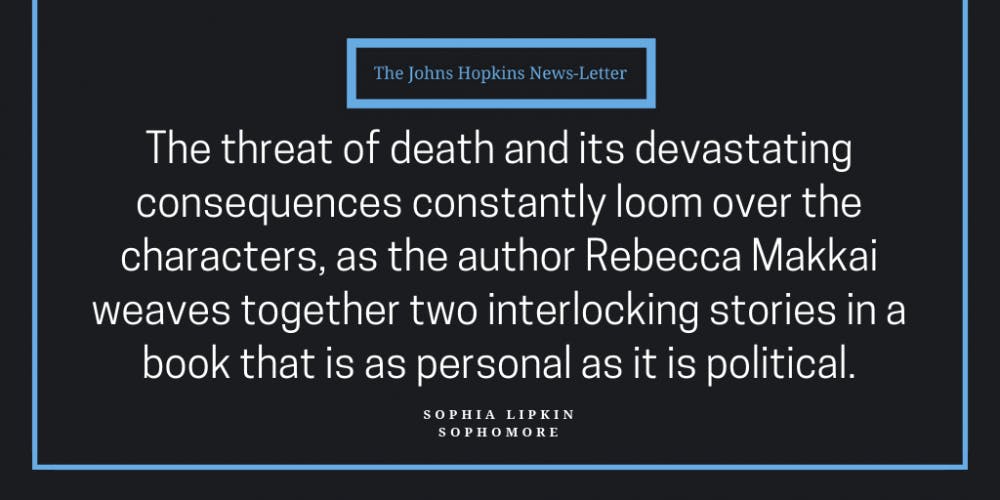The Great Believers begins, like all great novels, with a funeral — only not a funeral, exactly. Yale, the bookish and gentle main character, arrives with his dashing British boyfriend, Charlie, at the doorstep of a friend’s Chicago row home. It’s a gathering to celebrate the life of their friend, Nico.
Nico, only 21, has died of AIDS, and Yale’s friends, a group of gay men in their 20s, have gathered because they’ve been excluded from the funeral.
To give a bit of context, it’s 1985 and the AIDS crisis in Chicago has just begun.
The threat of death and its devastating consequences constantly loom over the characters, as the author Rebecca Makkai weaves together two interlocking stories in a book that is as personal as it is political.
In alternating chapters, the book follows Yale, who is a curator for the campus art gallery at Northwestern University. He attempts to solicit donations from wealthy donors, and Fiona, Nico’s younger sister, 30 years later in Paris.
Meanwhile, Fiona is searching for her estranged daughter and staying in the same city her great aunt lived in 100 years ago. Her visit coincides with the opening of the art show of a now-famous friend, whose photographs and videos now serve as a monument to a crisis that has been long forgotten.
Yale, engrossed in a web of lies and jealousy and fear at home, waiting for the next of his friends to die, is also trying to curate a show. Nico and Fiona’s great aunt, Nora, wants to give the museum her collection: sketches of famous painters in Paris in the 1910s and men who died in the war, men whose legacies she feels obligated to cement.
Nora speaks of Paris the same way that Fiona speaks of Chicago: “a ghost town.” In many ways, they’re in two parallel universes in two different cities, both recalling memories of loved ones who should have survived.
The modern chapters of the book sometimes drag, especially with the search for Fiona’s daughter. Yet, these chapters provide some of the most powerful moments in the book.
It’s a perspective without which the book loses much of its storytelling power. It is not simply about loss but also about survival.
And some of the most poignant moments come in these chapters, not through dialogue or sudden realizations but through offhand comments: What would life have been like if her brother had lived?
It is these moments where the story becomes truly devastating. Both Fiona and Yale are constantly looking back to Nico’s death. Nico is as much a character as Yale and Fiona, although he is fashioned through their memories and their memories alone.
Ultimately, his death — and not to mention those that follow it — is tragic not simply because it profoundly affects the main characters, but also because it affects the reader. We come to know him as the characters did, and through bits and pieces of memory, the story of his illness is retold.
Fiona’s chapters and the stories that Nora tells are both reminders of the staying power of memory. But the real tragedy of Fiona’s story is in the details she leaves out, the lives she chooses not to mention and the deaths that were too painful to ever think about.
The book is a slow, burning realization of what is to happen. It reads simultaneously too quickly and too slowly, much like the experience of life itself.
In one chapter, Yale laments the things his dying friends will never get to experience. It is not so much a chapter, but rather a poem.
Even the form of the novel plays an important role in the story. Fragments of sentences are crafted into singular lines of text so that they appear on the pages not as paragraphs, but as lines of text on a gravestone.
Proper nouns stand alone without the verbs that propel them into action, just like all the things that death can take from someone.
Art is a medium through which to tell stories, but it is also a medium through which to cement legacy. At one point, Nora speaks of Ranko Novak, an unknown artist and former lover whose legacy she is so determined to protect.
She meditates, “When someone’s gone and you’re the primary keeper of his memory — letting go would be a kind of murder wouldn’t it?”
Although the chapters are primarily set in the 1980s, they expose an important lesson that is adaptable to our contemporary age, one that Fiona screams at an unsuspecting journalist at the opening of her friend’s show.
“It’s art but I was there. Those were my friends.”
Maybe this is a quiet and subtle parallel to the portrayals in the book itself. In her author’s note, Makkai makes it explicit that these characters, while as close to the truth as possible, are fictional.
Yes, it is art. But it is important to remember that it was also someone’s life.





